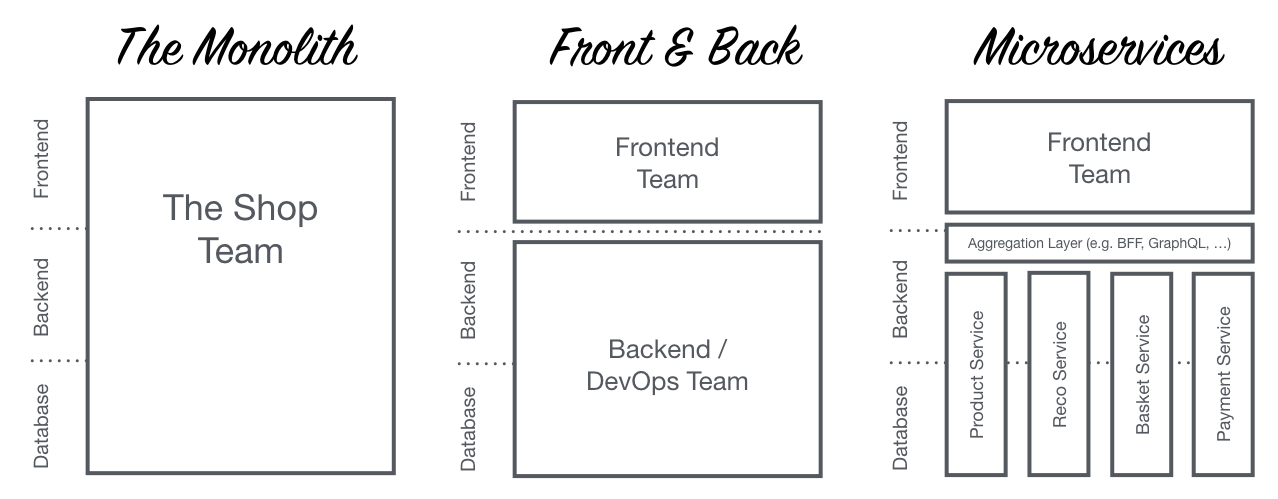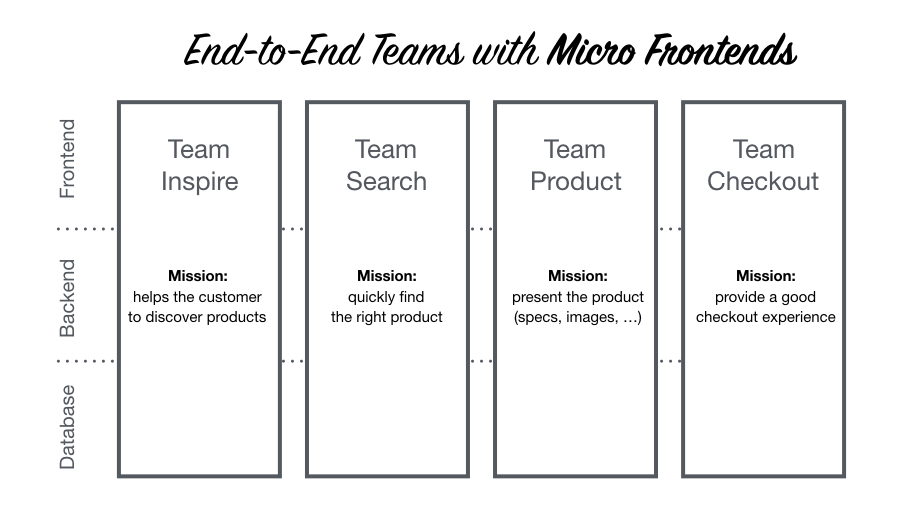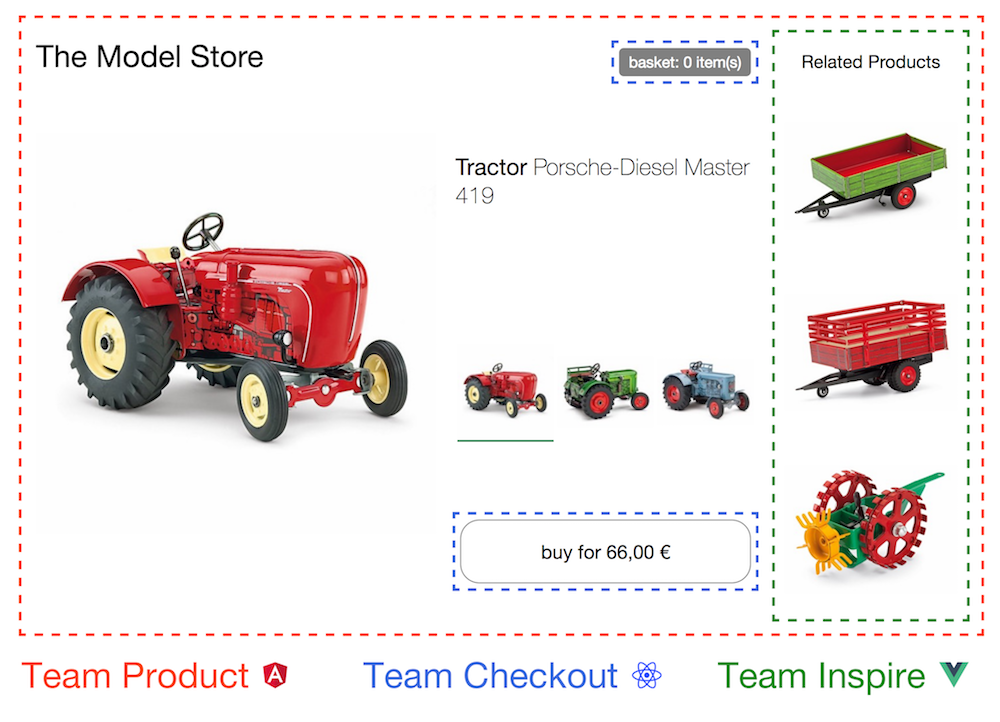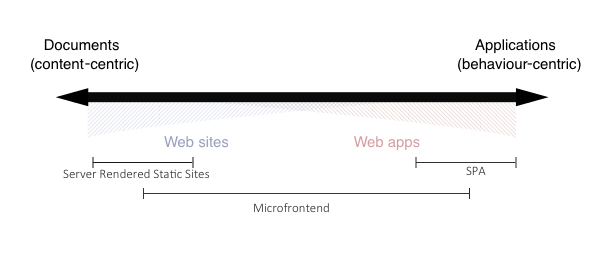Server-side Microfrontends
Voxxed Days Singapore - 30th - 31st May 2019
Server-side Microfrontends
About Me
- Software Engineer at Standard Chartered Bank
- Currently working in:
- Scala
- Kotlin
- Typescript
- Also DevOps
- Community involvements:
- OSS project maintainer
- Singapore Scala Meetup group organiser
- Engineers.SG volunteer
_hhandoko
hhandoko
hhandoko.com



Agenda
Overview of microfrontend architecture:
- The concept and core ideas
- Technology options
Microfrontends learnings from Standard Chartered:
- Context and adoption rationale
- Architecture and technology choices
- Challenges and benefits
- Future considerations
Overview of Microfrontend Architecture
Overview of Microfrontend Architecture
Overview of Microfrontend Architecture
What are microfrontends?
Core ideas:
- App is a composition of features owned by independent teams
- Each team has a distinct area of business or mission
- A team is cross-functional and develops its features end-to-end
Notes:
[1] - https://micro-frontends.org/#what-are-micro-frontends
Also known as:
- Frontend Integration for Verticalised Systems
- Self-contained Systems
Comparable concepts:
- Microapps in mobile
Extends the concept of microservices to the frontend.
Existing architectures

Notes:
[1] - https://micro-frontends.org/ressources/diagrams/organisational/monolith-frontback-microservices.png
Desired architecture

Notes:
[1] - https://micro-frontends.org/ressources/diagrams/organisational/verticals-headline.png
Microfrontends (in one pic)
Notes:
[1] - https://micro-frontends.org/ressources/screen/three-teams.png

Technology options
- Single-SPA meta-framework
- Multiple SPAs, each in different locations (contextual paths)
- Web Components / custom elements
- Client Side Includes (CSI)
- Edge Side Includes (ESI)
- Server Side Includes (SSI)
- IFrames
Microfrontend as an architectural and
team organisation approach,
not technology stacks
Context
Context
Context
Problems and challenges
Reinvention(s):
- Functionality overlap between different services and apps
- Monolith UI code are not easy to port between projects
- Domain knowledge are spread
- Enhancements are not uniformly applied to all services and apps
Problems and challenges (cont'd)
Intrinsic dependencies:
- Immense coordination effort to push a change to production
Dynamic coupling:
- Services (API) and apps (client) links can be brittle
- Compensate by using various testing methodologies (e.g. integration, contract-based)
Goals
Goals
Goals
Maximise reuse
Restructuring teams around business domains and capabilities:
- Customer Profile
- Customer Portfolio
- Recommendations
- etc.
Knowledge on specific domain can be transferable across regions and markets.
Team composition remains fluid, but enable better continuity from project to project.
Better isolation
Integration on 'last-mile':
- Feature development happens on one vertical until the point of integration.
Independent deployment:
- Each vertical can set its own development cadence and release schedule.
Risk containment:
- Complexity can be contained in one vertical, and the bugs along with it.
- Tests are 'cheaper' to run.
Architecture
and
Technology
Architecture
and
Technology
Architecture
and
Technology
Server-rendered web app
Customer requirements indicate that we were going to build a content-heavy web application, with only limited interactivity.

Notes:
[1] - https://cdn-images-1.medium.com/max/1600/1*NJMQCgyMShhjYx6dE_pbRw.png
[2] - https://medium.com/@areai51/microfrontends-an-approach-to-building-scalable-web-apps-e8678e2acdd6
[3] - https://2018.ar.al/notes/the-documents-to-applications-continuum/
Other considerations
Complexity lies in data sourcing and aggregation:
- Do we really need SPAs?
- Do we really need Javascript?
Offline first and PWAs:
- Viable alternative, but far more complex
CPU utilisation vs network latency:
- High network latency
First microfrontends?
- Bring your DevOps A-game!
Alternatives
skatejs:
- Web components / custom elements SSR
node-tailor:
- Streaming layout service
markojs:
- Async fragment loading



Notes:
[1] - https://skatejs.netlify.com/
[2] - https://github.com/zalando/tailor
[3] - https://markojs.com/
Edge Side Includes
Server Side Rendering:
- Renders viewable page, then extend with interactivity
- Only small difference from full client-side development
- Supported by popular Javascript SPA frameworks
Edge Side Includes:
- Renders page as-is by embedding content
- Small markup language, proposed as a spec to W3C
- Supported by CDNs and caching delivery providers
Notes:
[1] - https://en.wikipedia.org/wiki/Edge_Side_Includes
[2] - https://medium.com/walmartlabs/the-benefits-of-server-side-rendering-over-client-side-rendering-5d07ff2cefe8
ESI with nodesi
Customisations:
Replaced good-guy-http with Axios for consistency with the rest of the apps, contextual logging, tuneable retry strategy, and Bearer token header embeds.
Subset of ESI standard with a Promise-based interface.
Notes:
[1] - https://github.com/Schibsted-Tech-Polska/nodesi
<esi:include src="http://example.com/1.html"
alt="http://bak.example.com/2.html"
onerror="continue"/>Technology choices
Stacks:
- Typescript + Express + EJS
- Java + Spring Boot + Thymeleaf
- PostgreSQL
- Kafka
Build Tools:
- Gradle
- Backpack (Webpack)
Technology choices (cont'd)
Infrastructure:
- BitBucket + JIRA
- Jenkins
- Artifactory
- Rundeck
- OpenShift
Others:
- Docker and Docker compose
Typescript + Express + EJS
Optimise for Time to First Render:
- nodesi load fragments concurrently
- Server-side DOM manipulation prior to rendering
- HTML response minification
- GZip response compression
- HTTP/2 (SPDY) web server support
Future considerations:
- Server-side SVG graph generation
- Partial page refresh a la SPAs:
- Component-specific custom scripts with jQuery
- DOM patching with morphdom
Notes:
[1] - https://github.com/spdy-http2/node-spdy
[2] - https://github.com/patrick-steele-idem/morphdom
Java + Spring Boot + Thymeleaf
Optimise for clarity:
- Reduce 'magic', more explicit code flow
Optimise for fast response and small payload:
- Session-bound cache
- GZip (gz) response compression
Future considerations:
- Brotli (br) assets compression
- Typed template engine
- Other web frameworks:
- Spring WebFlux
- Micronaut
- Quarkus
- http4s
- akka-http
Notes:
[1] - https://github.com/fizzed/rocker
[2] - https://docs.spring.io/spring/docs/current/spring-framework-reference/web-reactive.html#spring-webflux
[3] - https://micronaut.io/
[4] - https://typelevel.org/cats-effect/datatypes/io.html
Page interaction
Progressive enhancements:
- Working page interaction on first render, additional interactivity after script loads
Agreed conventions:
- Navigation trigger methods
- Common vendor scripts
Future considerations:
- Use data-* attributes to pass additional data for actions / interaction
Development Experience
Development Experience
Development Experience
Minimal context switching
Monorepo for each vertical:
- Deployment module
- Data module
- Service / UI module
Services are broken down into small modules which are shared by runtime artifacts (i.e. apps).
End to end development within a (domain) boundary.
Multiple environments
Various environment-specific configurations:
- Spring Boot configuration profiles
- node-convict
- dotenv
Service mocks and API-compatible alternatives:
- H2 in local, Postgres elsewhere
- Mock LDAP server to simulate SSO
Multiple environments (cont'd)
Development setup and standalone mode via Docker compose:
- End-to-end UI development
- Standalone preview mode:
- Each service can be expanded to its full functionality
- Each service can be replaced with one from other environment
Development Overhead
Promote shared resource as a library:
- Styling-related resources (e.g. SASS, vendor JS, common assets, etc.) as an npm package
- Deployment manifest generator (Nodejs-based) as an npm package
- Jenkins shared library
- Docker base images and layers
Development overhead (cont'd)
Three types of resources available:
- JSON (via REST API)
- HTML fragment
- HTML page
JSON for external service consumption.
HTML fragments are the resource used for embedding in the web application.
HTML page format is used during development to provide an indication how the component will look and behave.
Observations
Observations
Observations
User Expectations
Implicit assumptions from modern web and mobile apps:
- Content 'jank' when performing page actions due to page reload
- Lack of immediate UI feedback from actions (e.g. loading spinner, content placeholders)
- Features that comes for 'free' in the Javascript ecosystem (e.g. table sorting)
Actual vs Perceived Performance
Good (+ resilient) on poor connection:
- First page load ~200kb:
- ~90kb custom webfonts
- ~30kb jQuery
- ~50kb styles + interactivity plugins
- Subsequent page loads ~5kb (+ scripts)
Scalability
Will it scale?
- Performance is inline with other, similar microservices architecture
- Low-footprint front-end
- Time to first byte is dependent on the critical path on concurrent fetch of (remote) UI components
- Server-side response optimisation, if enabled, adds 7 - 14ms overhead
Questions
and
Answers
Questions
and
Answers
Questions
and
Answers
Thank You!
Thank You
Image Attributions:
- https://www.vecteezy.com/vector-art/192201-seamless-memphis-background
- https://www.vecteezy.com/vector-art/275088-memphis-pattern-design
- https://www.pexels.com/photo/white-painted-wall-1939485/
